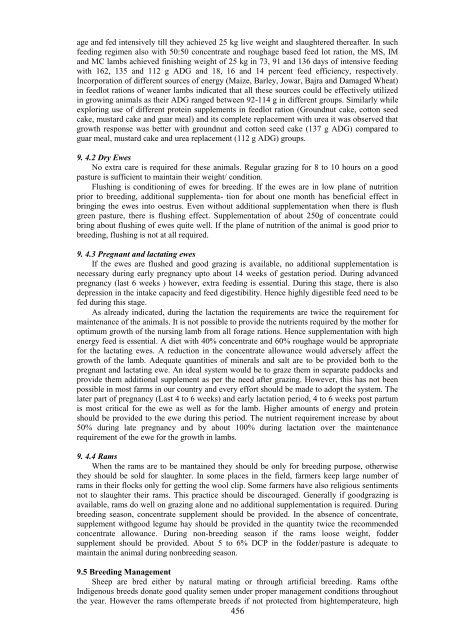Create successful ePaper yourself
Turn your PDF publications into a flip-book with our unique Google optimized e-Paper software.
age and fed intensively till they achieved 25 kg live weight and slaughtered thereafter. In such<br />
feeding regimen also with 50:50 concentrate and roughage based feed lot ration, the MS, IM<br />
and MC lambs achieved finishing weight of 25 kg in 73, 91 and 136 days of intensive feeding<br />
with 162, 135 and 112 g ADG and 18, 16 and 14 percent feed efficiency, respectively.<br />
Incorporation of different sources of energy (Maize, Barley, Jowar, Bajra and Damaged Wheat)<br />
in feedlot rations of weaner lambs indicated that all these sources could be effectively utilized<br />
in growing animals as their ADG ranged between 92-114 g in different groups. Similarly while<br />
exploring use of different protein supplements in feedlot ration (Groundnut cake, cotton seed<br />
cake, mustard cake and guar meal) and its complete replacement with urea it was observed that<br />
growth response was better with groundnut and cotton seed cake (137 g ADG) compared to<br />
guar meal, mustard cake and urea replacement (112 g ADG) groups.<br />
9. 4.2 Dry Ewes<br />
No extra care is required for these animals. Regular grazing for 8 to 10 hours on a good<br />
pasture is sufficient to maintain their weight/ condition.<br />
Flushing is conditioning of ewes for breeding. If the ewes are in low plane of nutrition<br />
prior to breeding, additional supplementa- tion for about one month has beneficial effect in<br />
bringing the ewes into oestrus. Even without additional supplementation when there is flush<br />
green pasture, there is flushing effect. Supplementation of about 250g of concentrate could<br />
bring about flushing of ewes quite well. If the plane of nutrition of the animal is good prior to<br />
breeding, flushing is not at all required.<br />
9. 4.3 Pregnant and lactating ewes<br />
If the ewes are flushed and good grazing is available, no additional supplementation is<br />
necessary during early pregnancy upto about 14 weeks of gestation period. During advanced<br />
pregnancy (last 6 weeks ) however, extra feeding is essential. During this stage, there is also<br />
depression in the intake capacity and feed digestibility. Hence highly digestible feed need to be<br />
fed during this stage.<br />
As already indicated, during the lactation the requirements are twice the requirement for<br />
maintenance of the animals. It is not possible to provide the nutrients required by the mother for<br />
optimum growth of the nursing lamb from all forage rations. Hence supplementation with high<br />
energy feed is essential. A diet with 40% concentrate and 60% roughage would be appropriate<br />
for the lactating ewes. A reduction in the concentrate allowance would adversely affect the<br />
growth of the lamb. Adequate quantities of minerals and salt are to be provided both to the<br />
pregnant and lactating ewe. An ideal system would be to graze them in separate paddocks and<br />
provide them additional supplement as per the need after grazing. However, this has not been<br />
possible in most farms in our country and every effort should be made to adopt the system. The<br />
later part of pregnancy (Last 4 to 6 weeks) and early lactation period, 4 to 6 weeks post partum<br />
is most critical for the ewe as well as for the lamb. Higher amounts of energy and protein<br />
should be provided to the ewe during this period. The nutrient requirement increase by about<br />
50% during late pregnancy and by about 100% during lactation over the maintenance<br />
requirement of the ewe for the growth in lambs.<br />
9. 4.4 Rams<br />
When the rams are to be mantained they should be only for breeding purpose, otherwise<br />
they should be sold for slaughter. In some places in the field, farmers keep large number of<br />
rams in their flocks only for getting the wool clip. Some farmers have also religious sentiments<br />
not to slaughter their rams. This practice should be discouraged. Generally if goodgrazing is<br />
available, rams do well on grazing alone and no additional supplementation is required. During<br />
breeding season, concentrate supplement should be provided. In the absence of concentrate,<br />
supplement withgood legume hay should be provided in the quantity twice the recommended<br />
concentrate allowance. During non-breeding season if the rams loose weight, fodder<br />
supplement should be provided. About 5 to 6% DCP in the fodder/pasture is adequate to<br />
maintain the animal during nonbreeding season.<br />
9.5 Breeding Management<br />
<strong>Sheep</strong> are bred either by natural mating or through artificial breeding. Rams ofthe<br />
Indigenous breeds donate good quality semen under proper management conditions throughout<br />
the year. However the rams oftemperate breeds if not protected from hightemperateure, high<br />
456




